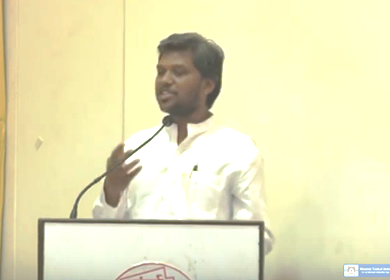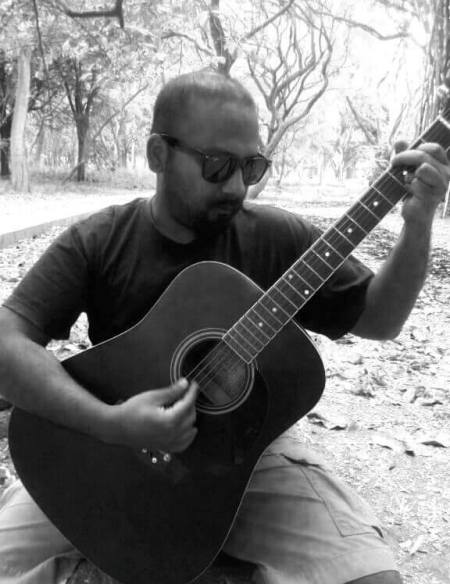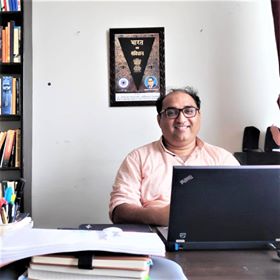Sthabir Khora
(Transcript of his speech at the ‘Discussion on the Constitutionality and Progressiveness of the EWS Quota for the so-called Upper Castes and the Repercussions for the SC/ST/OBC/Pasmanda Representation‘ held on 25th of Feb, 2019 at the Mumbai Marathi Patrakar Sangh, Fort, Mumbai.)
Jai Bhim to all, Jai Bhim.
The Honorable Mane sir, Kuffirda, James, Rahul. I am very thankful to all of you who have come. I am very thankful to the organisers who have given me a place alongside Mane sir. It is not easy to talk here as he is well versed on the topic. But I will just present my opinion; and some of it might go well and some of it might not.

This current 10% reservation is for the EWS category. This EWS category was first created in Right to Education. It’s very interesting that the EWS category in Right to Education implied SC/ST though technically it didn’t. But here it is just the opposite: here it looks like it is for the savarna. What I feel is that it has cleverly mixed two things – one positive thing and one negative thing – and it is trying to present a Catch 22 situation. A googly type of situation for SC/ST/OBC, which if you take there is problem and if you don’t take also there is problem.
Why this has been done? According to me, those who do politics are not fools and they know that people cannot be fooled easily and therefore they will combine the positive and negative thing to create a dilemma for the people. What is the positive here? This is crossing the 50% ceiling. This is the ground on which it is sold politically. The negative thing here is ‘exclusive economic criteria as a basis of reservation’ which is negative, dangerous. These two have been mixed and presented. Now there are articles which are coming up about this. People who see something positive in it discuss about the positive aspects. Of these, the first positive aspect is crossing the 50% ceiling. People feel that since it is given to the upper castes the Supreme Court will not oppose it and allow it to pass. If at all it is allowed, obviously the OBC will be happy thinking that, now we will get more than 27% reservation. Ok, this is based on the assumption that you have allowed (savarnas) there, so you will allow (us) here. Whichever Bahujan leaders supported this, if they are asked why did they support, they will say that, this is why we supported it- to break the 50% ceiling and to get some benefit from that.
But you cannot pick and choose between two components. You have to take it in total. If it is passed then both get passed. It will cross 50% ceiling as well as (bring in) reservations based on exclusive economic criteria. You cannot take them separately. What will the Supreme Court do? I will try to guess about what the Supreme Court is likely to do.
Benefit number two, which some people are saying is that, the stigma which has so far been with reservation will lessen. I think the stigma was never attached to reservation. The stigma upon the SC/ST was not due to reservation but because of their low caste. This is my sociological guess. And why do I think so? It’s because if reservation were to remove stigma, the total SC population would have considered themselves as one single unit. There would have been SC, ST, OBC Unity. There should not have been internal division, internal hierarchy within the SC if reservation where to remove stigma. If we imagine, are those Brahmins who will come under 10% quota going to face stigma? I don’t think so. Therefore, I don’t agree with those who are writing that this will remove the stigma. I don’t think so.

What is the strategy for people are who are advocating resistance to this if they think this is not right? I will call it the strategy of logic and fact, meaning you will apply the logic and you apply the fact. Fact is known to everybody that how much upper castes are represented in public and private sector. This fact is widely well known. This must be known to the Supreme Court because in Nagaraj judgement it was reiterated that you have to prove quantitatively (representation). But what percentage of people are in A, B, C, D category of employment – this was always known. I am from Sociology background and I don’t know so much about the law. But I don’t understand why reservation in promotion was not defended presenting thes facts. I don’t believe that the strategy of fact alone will work. In revision petition people will provide fact and logic.
Strategy of fact and logic will also not work, I feel, because the Court can give judgement without any fact or logic and we have examples. For example, we have this creamy layer judgement in promotions. I could never understand how you do not apply creamy layer at the entry stage but apply it during the promotion stage! How it was not relevant what the father was doing during the entry stage but was relevant during the promotion stage, while his own status should have been relevant! When we want to see income limit, what do we see – what he is doing as an adult. Then we delink his income from his father’s income. For example, when a girl leaves home after marriage, her father’s income may be crores. But that is never counted as her income. That woman’s income will be linked to her husband’s income. Therefore for a person, after joining a job, his income is cut off from his father’s. He or she is an independent person in his or her own right. Then how come Supreme Court is bringing his or her father in, at this stage (promotion)! And nobody can ask the Supreme Court, how can you do this.
For example, this Mahajan case (Dr. Subhash Kashinath Mahajan vs The State Of Maharashtra) regarding the filing of a false atrocity case. Here the police has decided it is a false case. And whatever police decides, that is not supposed to be admissible in the court. On the one side the court judgement and on the other side the police judgement and the statistics which were presented combining this two is totally illogical. But you cannot question. Therefore, I believe that strategy of logic and fact also do not work. We have seen enough of that. It is said that technical ground cannot be an obstacle to justice. For example, 482 of the CRPC which can cancel a FIR is basically an extraordinary power, which means technicalities doesn’t matter much before justice. In the recent judgement regarding Adivasi eviction where central government had not sent its lawyer, the Supreme Court could have always waited; should have asked the central government to bring its lawyer. It could have done so many things. It was not so necessary technically to give the judgement in the absence of the lawyer just because the lawyer didn’t come. But Supreme Court has done it. So, I don’t think strategy of fact and logic will work much.
And now what is the real issue? I don’t think that real issue is logic, fact, Parliament, Lok Sabha or Rajya Sabha. How long will the Supreme Court keep on giving such judgements and how long will these revision petitions and ordinances go on! The problem, I feel, is the lack of an inclusive judiciary, the root of the problem for SC/ST/OBC. I feel, we have a ‘Judiciary in India’ not ‘Judiciary of India’ because judiciary doesn’t have any link with the people. Technically, here the Judiciary appoints/selects itself. Judicial independence is what it is called here. There was an article in The Wire yesterday or day before and that was supporting the present system of independence of judiciary. A lot of people support independence of judiciary and a few oppose. What is after all this independence of judiciary? This is the issue in that article in The Wire.
It was written that if the collegium recommends something to the government and the government returns it and the collegium recommends it again then the government has to accept it and that is the law. This type of thing is written in the constitution regarding the exchanges between the President and Council of Ministers and Prime Minister. If Prime Minister along with the Council of Ministers send something second time after reconsideration to the President then the President is bound to accept that. This means that because it’s a democracy and because the Council of Ministers are from the parliament which is directly elected that’s why their power has to be more than that of the President. So, Council of Ministers are more powerful than the president. President technically appoints the judges. But Council of Ministers have to obey those judges. This has become some sort of contradiction. I don’t know whether any scholar has defended this collegium system. I don’t know whether this exists in other countries like UK or USA from which we derive our legal system. If it was good for democracy then it would have been there in UK or USA also. Then why it is not there?
Judicial independence is defined in India as judges appointing themselves. But I don’t think that this will be the meaning in jurisprudence. The second thing which is presented is that judicial independence is a virtue in itself like there is in philosophy the conception of ‘good’. Platonic ‘good’, is an abstract concept. What is good? Everything is good. It’s a virtue in itself. ‘Liberty’ – virtue in itself with some limits. ‘Freedom’ – virtue in itself with some limits. Even if independence is looked at like that then also it will have its limit. What is its limit? We have to see that.
Actually, in jurisprudence it is not accepted that independence is a virtue in itself. Independence is required for impartiality. If someone is not independent then he cannot be impartial. Independence is not a virtue in itself but is required only for impartiality. Like it is said that ‘justice is not only to be done but seen to be done’ – that’s why open courts are there and not secret procedures. Similarly, impartiality is also not only to be done but seen to be done. What happens in the collegium system is not transparent. Then how do we know it is impartial? How do people know that that is impartial? This is why I think that what we have ‘Judiciary in India’ and not ‘Judiciary of India’.
{youtube}ZOYiecdudSE{/youtube}
Finally, we come to what next? The system is operating in such a manner that today the Judiciary is ordering the eviction of lakhs of Adivasis and people are not thinking beyond a revision petition. And openly you cannot say that you will not obey the Supreme Court because then you will attract contempt. So, this is the kind of situation we have. The revision petition and such things are a strategy of logic and fact. I feel that SC/ST/OBC should exert their full energy on an inclusive judiciary. They can go to international forums. For example, the recent eviction judgement of 10-20 lakhs of Adivasis from their homes is like genocide. UN charter and sometimes the international community intervenes in the matter of genocide. This is that kind of situation. So, one thing is internationalisation of the problems which we are encountering because of lack of inclusive judiciary. The second thing is about different movements which have so far employed centralisation as a strategy. All the people are trying to assemble in Delhi and then try to do something in Delhi. That is one strategy. Ok, that’s fine. But if there is some amount of decentralisation then I think the cost will be less. I always think about cost-benefit approach to social movements. We should do peaceful constitutional representation, some movements or whatever the constitution allows before state High Court or even District Court for an inclusive judiciary. And the District Judge will forward the demand to High Court. This can be a decentralized social movement which is my suggestion.
~~~
Dr Sthabir Khora is Associate Professor in the School of Education, Tata Institute of Social Sciences. His book “Education and Teacher Professionalism” (2011, Jaipur: Rawat Publications) is recommended reading in the M.Ed Syllabus of Punjabi University, Patiala.










